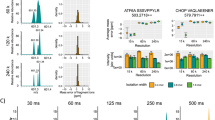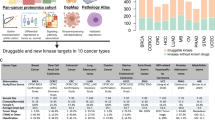Abstract
Most cancers are characterized by multiple molecular alterations, but identification of the key proteins involved in these signaling pathways is currently beyond reach. We show that the inhibitor PU-H71 preferentially targets tumor-enriched Hsp90 complexes and affinity captures Hsp90-dependent oncogenic client proteins. We have used PU-H71 affinity capture to design a proteomic approach that, when combined with bioinformatic pathway analysis, identifies dysregulated signaling networks and key oncoproteins in chronic myeloid leukemia. The identified interactome overlaps with the well-characterized altered proteome in this cancer, indicating that this method can provide global insights into the biology of individual tumors, including primary patient specimens. In addition, we show that this approach can be used to identify previously uncharacterized oncoproteins and mechanisms, potentially leading to new targeted therapies. We further show that the abundance of the PU-H71-enriched Hsp90 species, which is not dictated by Hsp90 expression alone, is predictive of the cell's sensitivity to Hsp90 inhibition.
This is a preview of subscription content, access via your institution
Access options
Subscribe to this journal
Receive 12 print issues and online access
$259.00 per year
only $21.58 per issue
Buy this article
- Purchase on Springer Link
- Instant access to full article PDF
Prices may be subject to local taxes which are calculated during checkout





Similar content being viewed by others
References
Ley, T.J. et al. DNA sequencing of a cytogenetically normal acute myeloid leukaemia genome. Nature 456, 66–72 (2008).
Parsons, D.W. et al. An integrated genomic analysis of human glioblastoma multiforme. Science 321, 1807–1812 (2008).
Hanash, S. & Taguchi, A. The grand challenge to decipher the cancer proteome. Nat. Rev. Cancer 10, 652–660 (2010).
Kolch, W. & Pitt, A. Functional proteomics to dissect tyrosine kinase signalling pathways in cancer. Nat. Rev. Cancer 10, 618–629 (2010).
Nomura, D.K., Dix, M.M. & Cravatt, B.F. Activity-based protein profiling for biochemical pathway discovery in cancer. Nat. Rev. Cancer 10, 630–638 (2010).
Brehme, M. et al. Charting the molecular network of the drug target Bcr-Abl. Proc. Natl. Acad. Sci. USA 106, 7414–7419 (2009).
Ashman, K. & Villar, E.L. Phosphoproteomics and cancer research. Clin. Transl. Oncol. 11, 356–362 (2009).
Zuehlke, A. & Johnson, J.L. Hsp90 and co-chaperones twist the functions of diverse client proteins. Biopolymers 93, 211–217 (2010).
Workman, P., Burrows, F., Neckers, L. & Rosen, N. Drugging the cancer chaperone HSP90: combinatorial therapeutic exploitation of oncogene addiction and tumor stress. Ann. NY Acad. Sci. 1113, 202–216 (2007).
Kamal, A. et al. A high-affinity conformation of Hsp90 confers tumour selectivity on Hsp90 inhibitors. Nature 425, 407–410 (2003).
Janin, Y.L. ATPase inhibitors of heat-shock protein 90, second season. Drug Discov. Today 15, 342–353 (2010).
Tsaytler, P.A., Krijgsveld, J., Goerdayal, S.S., Rudiger, S. & Egmond, M.R. Novel Hsp90 partners discovered using complementary proteomic approaches. Cell Stress Chaperones 14, 629–638 (2009).
da Rocha Dias, S. et al. Activated B-RAF is an Hsp90 client protein that is targeted by the anticancer drug 17-allylamino-17-demethoxygeldanamycin. Cancer Res. 65, 10686–10691 (2005).
Grbovic, O.M. et al. V600E B-Raf requires the Hsp90 chaperone for stability and is degraded in response to Hsp90 inhibitors. Proc. Natl. Acad. Sci. USA 103, 57–62 (2006).
Taldone, T. & Chiosis, G. Purine-scaffold hsp90 inhibitors. Curr. Top. Med. Chem. 9, 1436–1446 (2009).
Dezwaan, D.C. & Freeman, B.C. HSP90: the Rosetta stone for cellular protein dynamics? Cell Cycle 7, 1006–1012 (2008).
Ren, R. Mechanisms of BCR-ABL in the pathogenesis of chronic myelogenous leukaemia. Nat. Rev. Cancer 5, 172–183 (2005).
Burke, B.A. & Carroll, M. BCR-ABL: a multi-faceted promoter of DNA mutation in chronic myelogeneous leukemia. Leukemia 24, 1105–1112 (2010).
McClellan, A.J. et al. Diverse cellular functions of the Hsp90 molecular chaperone uncovered using systems approaches. Cell 131, 121–135 (2007).
Carayol, N. et al. Critical roles for mTORC2- and rapamycin-insensitive mTORC1-complexes in growth and survival of BCR-ABL-expressing leukemic cells. Proc. Natl. Acad. Sci. USA 107, 12469–12474 (2010).
Nobukuni, T., Kozma, S.C. & Thomas, G. hvps34, an ancient player, enters a growing game: mTOR Complex1/S6K1 signaling. Curr. Opin. Cell Biol. 19, 135–141 (2007).
McCubrey, J.A. et al. Targeting survival cascades induced by activation of Ras/Raf/MEK/ERK, PI3K/PTEN/Akt/mTOR and Jak/STAT pathways for effective leukemia therapy. Leukemia 22, 708–722 (2008).
Häcker, H. & Karin, M. Regulation and function of IKK and IKK-related kinases. Sci. STKE 2006, re13 (2006).
Mihailovic, T. et al. Protein kinase D2 mediates activation of nuclear factor kappaB by Bcr-Abl in Bcr-Abl+ human myeloid leukemia cells. Cancer Res. 64, 8939–8944 (2004).
Hendriks, R.W. & Kersseboom, R. Involvement of SLP-65 and Btk in tumor suppression and malignant transformation of pre-B cells. Semin. Immunol. 18, 67–76 (2006).
Mahajan, S. et al. Transcription factor STAT5A is a substrate of Bruton's tyrosine kinase in B cells. J. Biol. Chem. 276, 31216–31228 (2001).
Oda, A., Wakao, H. & Fujita, H. Calpain is a signal transducer and activator of transcription (STAT) 3 and STAT5 protease. Blood 99, 1850–1852 (2002).
Si, J. & Collins, S.J. Activated Ca2+/calmodulin-dependent protein kinase IIgamma is a critical regulator of myeloid leukemia cell proliferation. Cancer Res. 68, 3733–3742 (2008).
Salgia, R. et al. Increased tyrosine phosphorylation of focal adhesion proteins in myeloid cell lines expressing p210BCR/ABL. Oncogene 11, 1149–1155 (1995).
Le, Y. et al. FAK silencing inhibits leukemogenesis in BCR/ABL-transformed hematopoietic cells. Am. J. Hematol. 84, 273–278 (2009).
Sawyers, C.L. The role of myc in transformation by Bcr-Abl. Leuk. Lymphoma 11, 45–46 (1993).
Naka, K. et al. TGF-beta-FOXO signaling maintains leukemia-initiating cells in chronic myeloid leukemia. Nature 463, 676–680 (2010).
Bedford, M.T. & Clarke, S.G. Protein arginine methylation in mammals: who, what, and why. Mol. Cell 33, 1–13 (2009).
Maloney, A. et al. Gene and protein expression profiling of human ovarian cancer cells treated with the heat shock protein 90 inhibitor 17-allylamino-17-demethoxygeldanamycin. Cancer Res. 67, 3239–3253 (2007).
Jaganathan, S., Yue, P. & Turkson, J. Enhanced sensitivity of pancreatic cancer cells to concurrent inhibition of aberrant signal transducer and activator of transcription 3 and epidermal growth factor receptor or Src. J. Pharmacol. Exp. Ther. 333, 373–381 (2010).
Apsel, B. et al. Targeted polypharmacology: discovery of dual inhibitors of tyrosine and phosphoinositide kinases. Nat. Chem. Biol. 4, 691–699 (2008).
Deininger, M.W. & Druker, B.J. Specific targeted therapy of chronic myelogenous leukemia with imatinib. Pharmacol. Rev. 55, 401–423 (2003).
Katzav, S. Flesh and blood: the story of Vav1, a gene that signals in hematopoietic cells but can be transforming in human malignancies. Cancer Lett. 255, 241–254 (2007).
Pratt, W.B., Morishima, Y. & Osawa, Y. The Hsp90 chaperone machinery regulates signaling by modulating ligand binding clefts. J. Biol. Chem. 283, 22885–22889 (2008).
de Groot, R.P., Raaijmakers, J.A., Lammers, J.W., Jove, R. & Koenderman, L. STAT5 activation by BCR-Abl contributes to transformation of K562 leukemia cells. Blood 94, 1108–1112 (1999).
An, W.G., Schulte, T.W. & Neckers, L.M. The heat shock protein 90 antagonist geldanamycin alters chaperone association with p210bcr-abl and v-src proteins before their degradation by the proteasome. Cell Growth Differ. 11, 355–360 (2000).
Klejman, A. et al. The Src family kinase Hck couples BCR/ABL to STAT5 activation in myeloid leukemia cells. EMBO J. 21, 5766–5774 (2002).
Xu, D. & Qu, C.K. Protein tyrosine phosphatases in the JAK/STAT pathway. Front. Biosci. 13, 4925–4932 (2008).
Lim, C.P. & Cao, X. Structure, function and regulation of STAT proteins. Mol. Biosyst. 2, 536–550 (2006).
Paukku, K. & Silvennoinen, O. STATs as critical mediators of signal transduction and transcription: lessons learned from STAT5. Cytokine Growth Factor Rev. 15, 435–455 (2004).
Rix, U. & Superti-Furga, G. Target profiling of small molecules by chemical proteomics. Nat. Chem. Biol. 5, 616–624 (2009).
Acknowledgements
This work was supported in part by the Geoffrey Beene Cancer Research Center of the Memorial Sloan-Kettering Cancer Center (G.C.), Leukemia and Lymphoma Society (G.C., M.L.G., S.D.N., X.Z. and R.L.), Breast Cancer Research Fund (G.C.), the SPORE Pilot Award and Research & Therapeutics Program in Prostate Cancer (G.C.), the Hirshberg Foundation for Pancreatic Cancer (G.C.), the Byrne Fund (G.C.), 1U01 AG032969-01A1 (G.C.), 1R01 CA155226-01 (G.C. and A.M.) and US National Cancer Institute (NCI) Cancer Center Support Grant P30 CA08748 (H.E.B.). K.B. and L.N. were supported by funds from the Intramural Program of the NCI. S.M.L. and P.M.S.-J. are supported by the Ludwig Center for Cancer Immunotherapy at MSKCC and by NCI Grant P50-CA86483. M.L.G. is funded by the US National Institutes of Health (NIH) through the NIH Director's New Innovator Award Program, 1 DP2 OD007399-01 and the V foundation. F.P. is funded by the American Italian Cancer Foundation. We thank D. Toft (Mayo Clinic) and M. Cox (University of Texas) for the gifts of H9010 Hsp90-specific antibodies, L.A. Fabrizio, A.M. Morrishow, H. Deng and J. Fernandez for help with MS analysis, A. Perl, C.T. Jordan, M. Becker and J. Nicoll for providing the primary CML samples or suggestions on their use, and B. Clarkson, J. Bromberg and P. Gregor for suggestions with the manuscript.
Author information
Authors and Affiliations
Contributions
K.M., J.H.A., H.Z., L.C., A.R., K.B., P.S.-J., F.P., K.H., L.P.V., X.Z., H.E.-B., N.P. and T.K. performed experiments and D.Z., T.T., A.R., R.L., S.M.L., M.L.G. and S.S.G. provided reagents. All authors participated in the design and analysis of various experiments and G.C., A.M., S.D.N., M.L.G. and L.N. wrote the paper.
Corresponding authors
Ethics declarations
Competing interests
Memorial Sloan-Kettering Cancer Center holds the intellectual rights to PU-H71. Samus Therapeutics, of which G.C. has partial ownership, has licensed PU-H71.
Supplementary information
Supplementary Text and Figures
Supplementary Methods and Supplementary Results (PDF 3530 kb)
Supplementary Data Set 1
Dataset 1 (XLS 312 kb)
Supplementary Data Set Legend
Dataset 1 Legend (PDF 51 kb)
Rights and permissions
About this article
Cite this article
Moulick, K., Ahn, J., Zong, H. et al. Affinity-based proteomics reveal cancer-specific networks coordinated by Hsp90. Nat Chem Biol 7, 818–826 (2011). https://doi.org/10.1038/nchembio.670
Received:
Accepted:
Published:
Issue Date:
DOI: https://doi.org/10.1038/nchembio.670
This article is cited by
-
Structural and functional complexity of HSP90 in cellular homeostasis and disease
Nature Reviews Molecular Cell Biology (2023)
-
Computational biophysics approach towards the discovery of multi-kinase blockers for the management of MAPK pathway dysregulation
Molecular Diversity (2023)
-
Systems-level analyses of protein-protein interaction network dysfunctions via epichaperomics identify cancer-specific mechanisms of stress adaptation
Nature Communications (2023)
-
Small-molecule inhibitor targeting the Hsp70-Bim protein–protein interaction in CML cells overcomes BCR-ABL-independent TKI resistance
Leukemia (2021)
-
Pharmacologically controlling protein-protein interactions through epichaperomes for therapeutic vulnerability in cancer
Communications Biology (2021)



